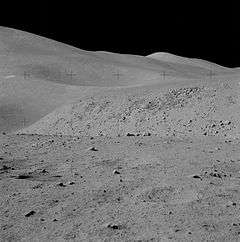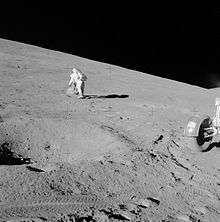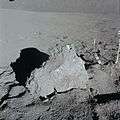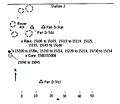St. George (crater)
St. George is a feature on Earth's Moon, a crater in the Hadley–Apennine region. Astronauts David Scott and James Irwin drove their rover onto what was suspected to be its ejecta blanket in 1971, on the Apollo 15 mission, during EVA 1. They collected samples to the northeast of the crater, at Geology Station 2 of the mission.
 Apollo 15 panoramic camera image | |
| Coordinates | 25.96°N 3.54°E |
|---|---|
| Diameter | 2.42 km[1] |
| Eponym | Astronaut-named feature |

View of St. George (slightly above left of center) facing south from the rim of Hadley Rille (Geology Station 9)
St. George crater is located on the west slope of Mons Hadley Delta and approximately 4 km southwest of the Apollo 15 landing point. Bridge crater is to the northwest and Elbow crater is to the northeast.
The name of the crater was formally adopted by the IAU in 1973.[1]
Station 2
 David Scott collecting samples from a boulder down the northeast slope from the rim of St. George
David Scott collecting samples from a boulder down the northeast slope from the rim of St. George The boulder at Station 2
The boulder at Station 2 Station 2 map.[2] X indicates sample locations, 5-digit numbers are LRL sample numbers, rectangle is lunar rover (dot indicates TV camera), black spots are large rocks, dashed lines are crater rims or other topographic features, and triangles are panorama stations.
Station 2 map.[2] X indicates sample locations, 5-digit numbers are LRL sample numbers, rectangle is lunar rover (dot indicates TV camera), black spots are large rocks, dashed lines are crater rims or other topographic features, and triangles are panorama stations.
External links
- Apollo 15 Traverses, Lunar Photomap 41B4S4(25)
References
- St. George, Gazetteer of Planetary Nomenclature, International Astronomical Union (IAU) Working Group for Planetary System Nomenclature (WGPSN)
- Apollo 15 Preliminary Science Report, 1972, NASA SP-289, Scientific and Technical Information Office, NATIONAL AERONAUTICS AND SPACE ADMINISTRATION, Washington, D.C.
This article is issued from Wikipedia. The text is licensed under Creative Commons - Attribution - Sharealike. Additional terms may apply for the media files.